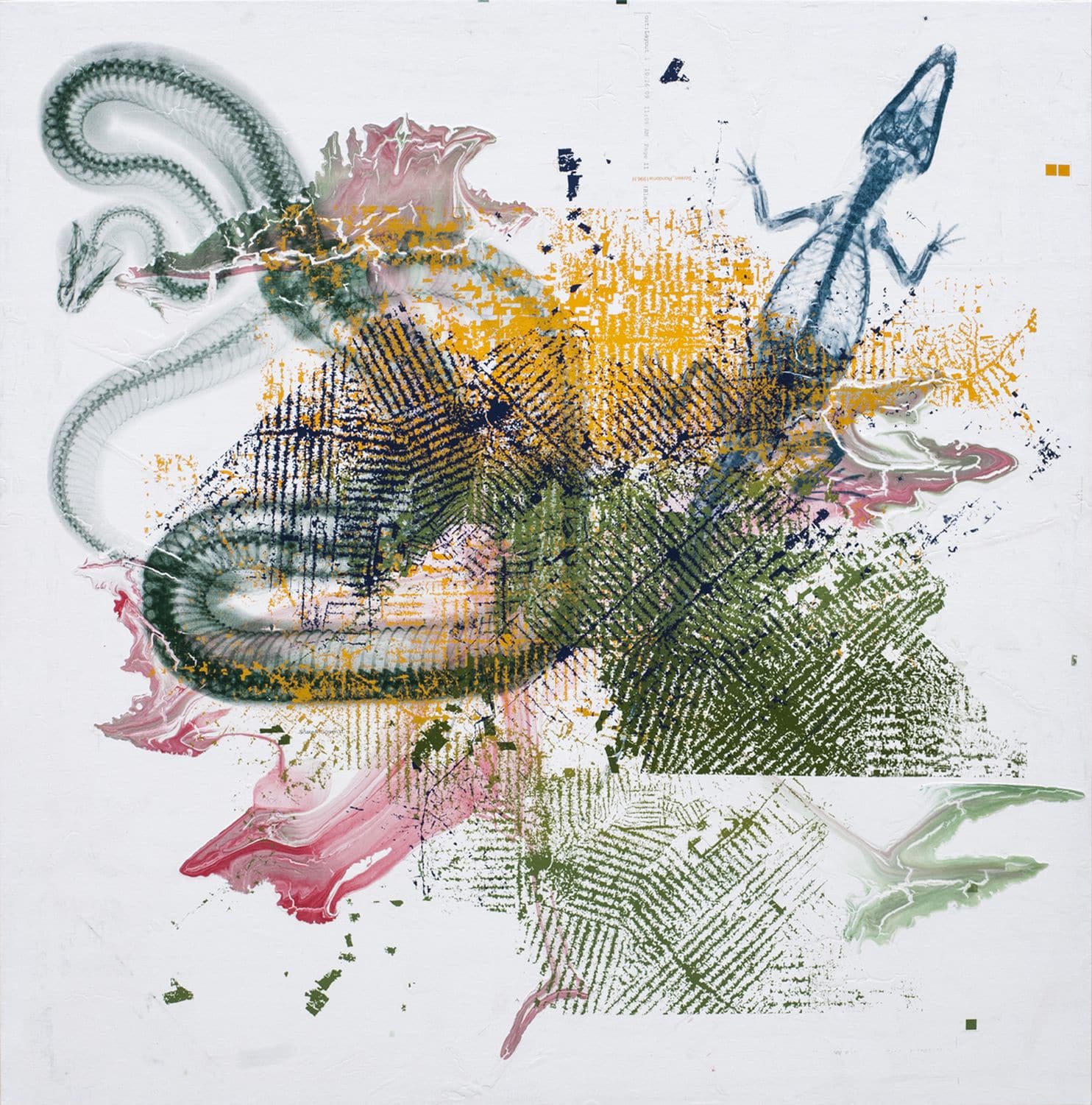
The Washington Post
Review
From the Amazon and the Arctic, images of two disappearing landscapes
By

Steve Miller incorporates the inhabitants of the Amazon in his art, using X-rays of plants and animals and layering them with satellite imagery of the dwindling forest. Above is “Forces at Play,” an acrylic and silk-screen on canvas. (Steve Miller/Steve Miller)
How does an artist express disappearance in a still image? It’s a question for which Steve Miller and Diane Tuft have very different answers, as each attempts to represent change in very different regions: the Amazon and the Arctic.
The link between the two New York artists’ work, on display at the National Academy of Sciences, is that the territories they depict are vital to everyone on Earth. Continued destruction of the Amazon rain forests will cripple what’s often called “the lungs of the planet,” while defrosting the Arctic region will lead to wilder weather and dramatically rising sea levels.
Those threats can’t be captured in photographs, even ones as sweeping and evocative as Tuft’s. But the pictures in her “The Arctic Melt: Images of a Disappearing Landscape” document a formerly stable realm that’s inexorably liquefying. Made during the summers of 2015 and 2016 in Norway, Greenland and at sea, the images are studies in flow, flux and drip, drip, drip.
A 2012 study published in the Proceedings of the National Academy of Sciences projected that the Arctic would experience its first ice-free summer sometime between 2054 and 2058. The Arctic Council, an intergovernmental forum of Arctic states, forecasts an earlier date: 2040.
Much is still refrigerated in the places Tuft visited. Some of her pictures of frozen formations are ice-white with just glimmers of watery blue. The tightest close-ups, such as “Ice Fold,” resemble minimalist abstract paintings. It starkly depicts an azure ribbon down one side of a white expanse.
The colors are equally vivid in such wider views as “Meltwater, Greenland Ice Sheet,” awash in aquas, and “Broken Arches, Disko Bay, Greenland,” in which light twinkles on open water. But these glimpses of an unfrozen North, some of them shot from an airplane or a helicopter, are also ominous. Discharged from glaciers, icebergs and ice sheets, that picturesque water is headed this way.
Unlike Tuft, who depicts only landscapes, Miller incorporates the inhabitants of the region he explores in his art. But he doesn’t show them from the outside. He uses X-rays of Amazon plants and animals, which he layers atop satellite imagery of the dwindling forest. (The aerial surveys come from the Woods Hole Research Center in Massachusetts.)
The resulting paintings and silk-screen and inkjet prints represent the interconnectedness of forest, flora and fauna in visual metaphors. Lizard skeletons resemble the natural branching structures of rivers and streams, but also the man-made webs of roads and trails. The ribbon of blue in “Kaleidoscope” might be a spine, an artery or a river — or a highway that opens the jungle like a gaping machete wound.
Miller incorporates X-rays of turtles, birds, fish, snakes and small mammals, as well as of flowers, root bulbs and seed pods. There are no humans, but their presence is manifest. They build the roads, bulldoze the trees and burn the fields. They also destroy more directly, as memorialized in “Shot Sloth Pieta,” which places under a glass plate an image of the remains of a mother and child of a vulnerable species. The glass has been shattered by a shot to the heart (or thereabouts).
As an alternative to killing for sport, Miller offers such “eco-trophies” as a white surfboard (exemplifying Brazilian beach culture) embellished with a black X-ray image of a caiman. The combination of board and reptile is cool, but not killer.
The overprinting of images in Miller’s work is visually engrossing and symbolic of the forest’s overlapping systems and relationships. Sometimes, the artist stops to contemplate individuals. Some of his most striking pieces show the skeletal form of a lone creature on a black background. They demonstrate the beauty and complexity of a single organism.
Yet single organisms exist only in art, not in nature. Whether near the equator or above the Arctic Circle, all of the pieces are connected, whether they fit inside the observer’s frame or not. Miller and Tuft portray worlds that might seem exotic or remote. In ecological terms, though, they’re right next door.
National Academy of Sciences; 2101 Constitution Ave. NW. 202-334-2415. cpnas.org/exhibitions.
Dates: “Miller” through Jan. 31, “Arctic Melt” through Feb. 20. On Feb. 15 at 6 p.m., Tuft will discuss her work at a D.C. Art Science Evening Rendezvous at the National Academy of Sciences.
Admission: Free. Open to the public; registration and photo ID required.
